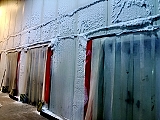Cold Storage – Health & Safety
Ice, frost, snow, fog and condensation can all occur whenever warm humid air comes into contact with a colder surface or environment. When cold store doors are open, a turbulent exchange of air occurs across the door space.
Moisture from outside air condenses on the cold store floor and other surfaces producing ice, frost and snow. This phenomenon creates a slippery surface; a serious hazard to staff and fork lift operators. Ice forming on ceilings will gradually increase in thickness and unless build-up is removed regularly, there is a serious risk of it collapsing, potentially causing injury to personnel.
When humid air meets cold store air around doors and traffic routes, moisture vapour can condense to create low level fog that reduces visibility; another potential safety issue, especially with fork lift drivers.
Refrigeration Plant Efficiency
As cold store air is circulated through the evaporator coil, airborne moisture vapour condenses and then freezes to form frost. Moisture originates from the product and personnel, but by far the greatest source is from outside air infiltrating into the store through doors.
Frost build up on the evaporator coils reduces the overall heat transfer coefficient and impedes air circulation. Both cause deterioration in the performance of the evaporator and refrigeration plant. A decrease in coil efficiency causes the compressor to work for longer periods and can reduce the refrigerant evaporating temperature. Both factors increase energy consumption.
Regular defrosting of the evaporator is necessary because equipment performance deteriorates with increasing thickness of ice. This is an expensive operation which adds to the heat load of the cold store. Nevertheless, as equipment performance deteriorates with increasing ice thickness it is necessary to defrost periodically.
A desiccant dehumidifier operates by extracting moisture in its vapour state and is able to effectively remove moisture without producing condensation (or frost). In most cases, a dry air supply of minus 20°Cdp or lower is easily attainable. The air is ducted into distribution boxes above the cold store doors, the resulting curtain of dry air providing an effective barrier against moisture infiltration. In addition, there are a number of other solutions to eliminate or reduce the overall moisture load into freezer.
We supply DehuTech DT-1500 – 5800 units for freezers.
